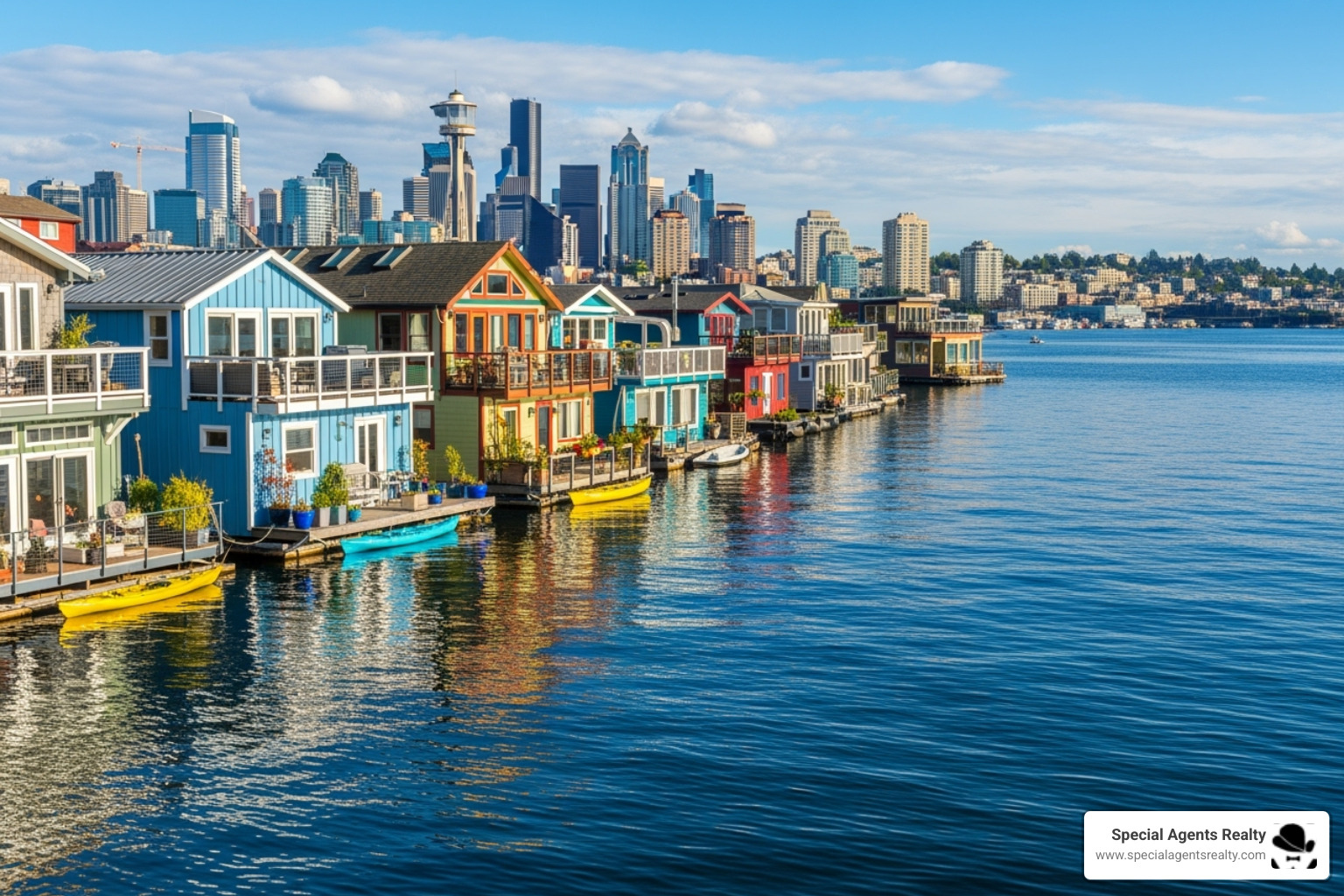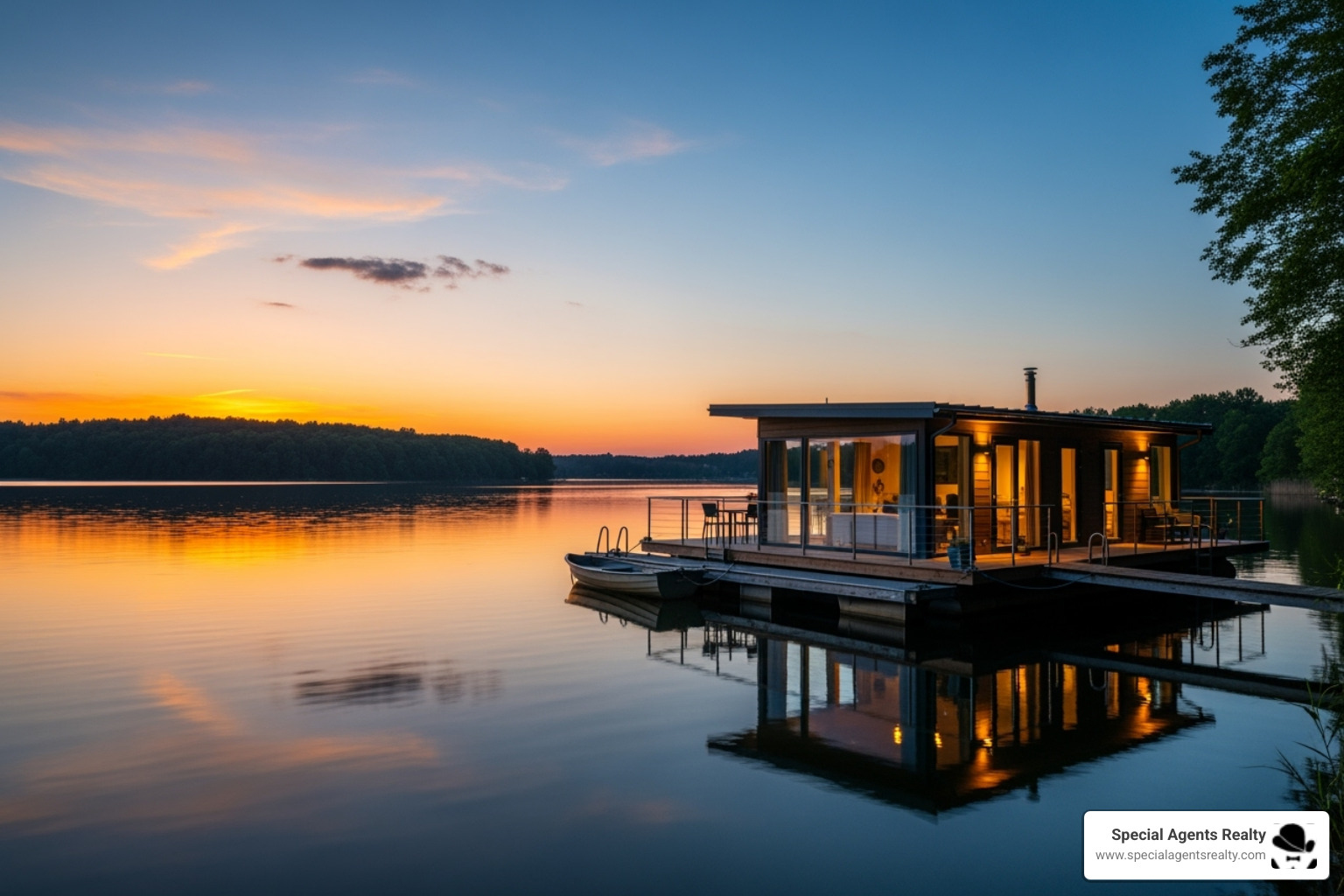
Find the Reality of Lake Washington Houseboats
Lake Washington houseboats offer a unique Seattle living experience, combining stunning views with a tight-knit community. However, before diving in, understand the market, lifestyle, and specific regulations that differ from traditional housing.
Quick Facts About Seattle's Floating Homes:
- Market Size: Roughly 500 floating homes in the Seattle area.
- Median List Price: $738,000 (as of recent market data).
- Average Days on Market: 86 days.
- Primary Locations: Lake Union, Portage Bay, and the Lake Washington Ship Canal.
- Key Difference: Floating homes are permanent structures; houseboats (FOWRs) are vessels that can be moved.
Seattle's floating home community dates to the early 1900s, evolving from affordable housing for laborers into today's highly sought-after residences. But what many don't realize is that not all water-based homes are the same. The term "houseboat" is often used as a catch-all, but Seattle recognizes distinct categories with different legal and financial implications.
This guide cuts through the confusion. We'll explain the differences between floating homes and houseboats, detail the costs of living on the water, and walk you through the specialized buying process. Whether you dream of kayaking from your front door or just want to understand this unique market, you'll find the practical information you need.
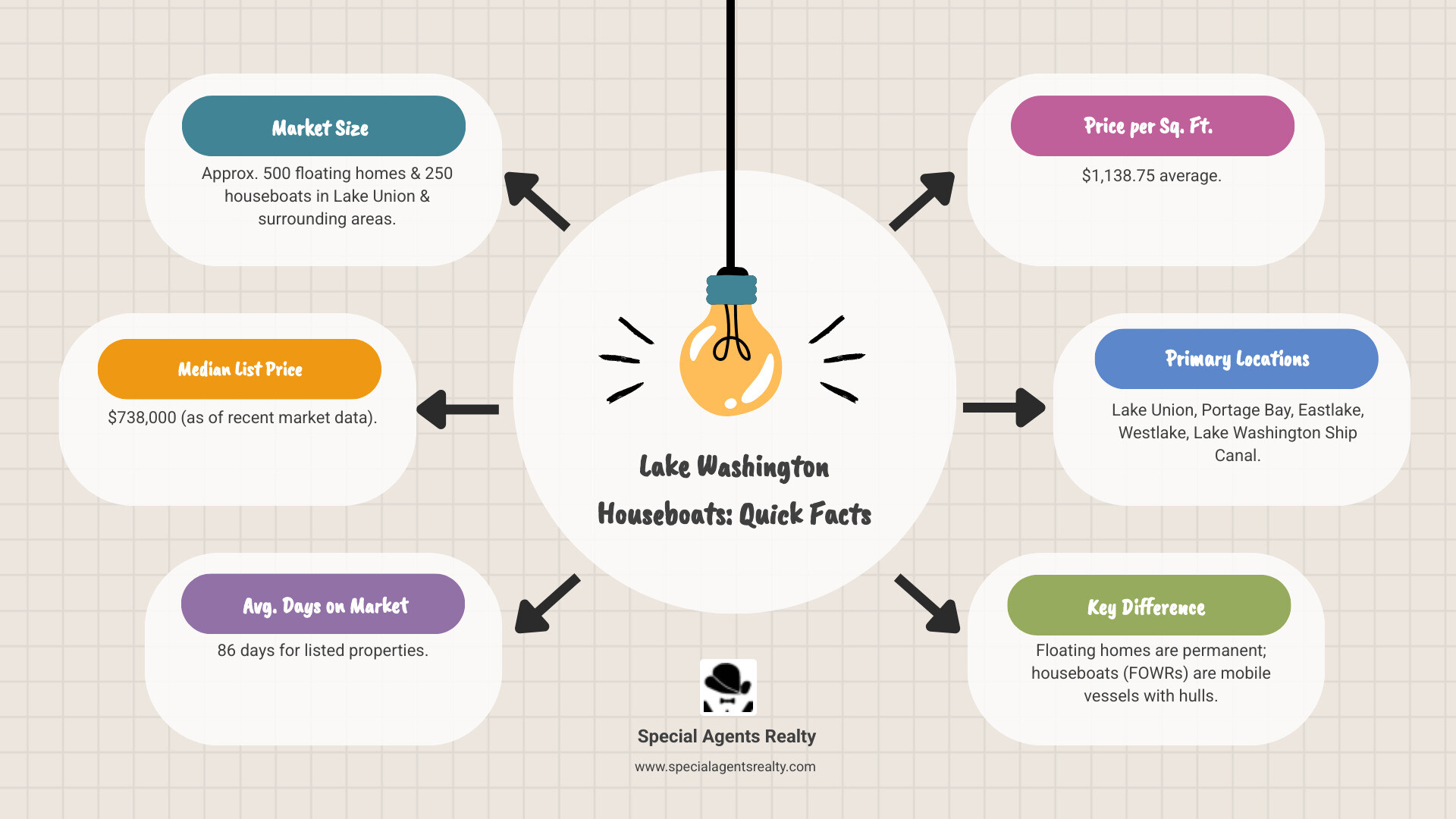
Floating Home vs. Houseboat: What's the Difference?
Many people looking at Lake Washington houseboats are surprised to learn that not all floating homes are houseboats. The terms are often used interchangeably, but the Seattle Department of Planning and Development (DPD) views them as entirely different structures. These distinctions affect everything from your mortgage options to your utility bills.
From the shore, they may look similar, but the key difference is mobility. A floating home is a permanent structure that stays put, while a houseboat is technically a vessel that can be moved. In Seattle, houseboats are officially called Floating On-water Residences, or FOWRs.
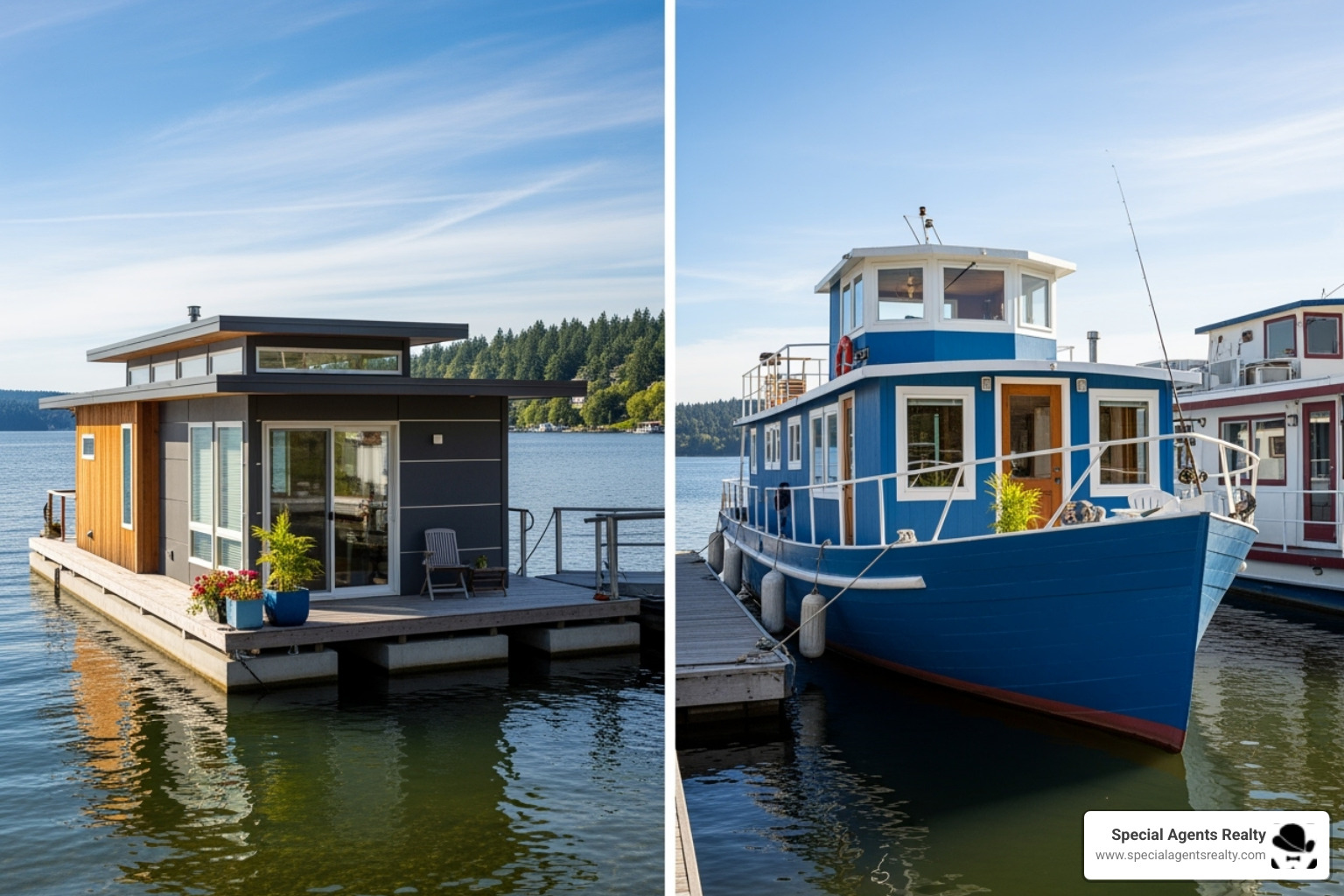
Think of floating homes as traditional houses on water. They are built on concrete floats (or older, treated logs) and can be quite spacious, with full amenities. Once towed to a legally established moorage, a floating home is permanently connected to the city's sewer and electrical grid.
Houseboats (FOWRs) are different. As vessels with hulls, they are designed to be moved. They are generally smaller and more like sophisticated RVs, with systems for waste storage (holding tanks) and limited electrical hookups (typically 30 amps). Waste requires regular pump-out services, and graywater discharge regulations can be a point of contention.
The DPD issues specific plaques for each type: "floating home" for permanent structures and "floating on-water residence" for houseboats. This designation determines which regulations, financing, and maintenance schedules apply.
Key Distinctions at a Glance
Here's a clear breakdown of how floating homes and houseboats compare:
| Feature | Floating Home | Houseboat (FOWR) |
|---|---|---|
| Mobility | Immovable; towed only for major maintenance. Often bought with the slip it's anchored in. | Can travel or be towed; functions as a vessel. |
| Utilities | Full grid connection for electricity, direct sewer hookup. | Limited power (typically 30 amps); waste stored in holding tanks, requires pump-out services. Graywater discharge often into the water (point of contention). |
| Ownership | Typically includes ownership of the slip/moorage, often part of a co-op or HOA. | Moorage is usually rented. |
| Construction | Built on concrete floats (modern) or treated logs (older); single-family structure. | Built with a hull, designed as a vessel. |
| Financing | Specialized mortgages available from specific banks (e.g., Sound Community Bank, Banner Bank). | Specialized mortgages available, but sometimes more challenging due to vessel status. |
| Size & Space | Can be quite large, up to 1,800 sq ft; more traditional house layout. | Generally smaller, more compact; akin to an RV or small apartment. |
| Maintenance | Dive inspections for floats every few years. | Drydock examination for hull every 3-6 years. |
| Regulations | DPD "floating home" plaque. Subject to Shoreline Master Program. | DPD "floating on-water residence" plaque. Subject to vessel regulations and liveaboard rules. |
Understanding these differences is the first step toward making a smart decision about waterfront living. The type of structure you choose will shape your entire experience.
Finding Your Spot on the Water: A Guide to Lake Washington Houseboats
The market for Lake Washington houseboats is tight. With only around 500 floating homes in the entire Seattle area and limited space for new construction, properties don't come up often. This scarcity drives the median list price to $738,000, with an average of $1,138.75 per square foot. These figures from the Northwest Multiple Listing Service (NWMLS) reflect a lifestyle people are willing to invest in.
While the search term is Lake Washington houseboats, most residential floating structures are on Lake Union and the Lake Washington Ship Canal. These communities offer incredible access to Seattle's amenities while maintaining a peaceful, water-based lifestyle.
Working with a specialist is essential. The nuances of floating home ownership—from co-op structures to financing—require specialized knowledge. At Special Agents Realty, we guide buyers through these unique challenges to find the right floating home for their lifestyle.
Primary Locations and Communities
The heart of Seattle's floating home scene is centered around Lake Union and its connected waterways.
- Lake Union: The largest concentration of floating homes, offering iconic views of the Space Needle, Gas Works Park, and the Seattle skyline.
- Portage Bay: Connecting Lake Union to Lake Washington, this area offers calmer waters and a more intimate community feel, close to the University District.
- Eastlake: Home to one of Seattle's most established floating home communities along Fairview Avenue E, with the Burke Gilman Trail running nearby.
- Westlake: On Lake Union's western shore, it provides easy access to downtown and the South Lake Union neighborhood.
- Lake Washington Ship Canal: Winding from Lake Union toward Puget Sound, this area features unique houseboats with a distinct maritime feel.
Each dock has its own personality, from quiet and professional to buzzing with families. The community culture is a huge part of the appeal, with neighbors sharing dock space, weather stories, and potlucks.
The Buying Process and Securing a Mortgage
Buying a floating home is different from a land-based purchase. Financing comes first, and it's not a typical mortgage. Traditional banks often decline, so you'll need to work with lenders who specialize in this market, such as Sound Community Bank and Banner Bank. Getting pre-approved is crucial in a competitive market to show sellers you're a serious buyer.
The inspection process is also specialized. Dive inspections are standard for floating homes, where a professional diver examines the concrete float. For houseboats, the process involves drydocking—pulling the vessel from the water for a thorough hull inspection every three to six years.
Finally, you'll need to understand the ownership structure. Many floating homes include an owned slip as part of a co-op or HOA. Houseboats, on the other hand, typically involve renting your moorage space. This distinction affects both your monthly costs and long-term flexibility.
Typical Costs of Lake Washington Houseboats
Beyond the purchase price, floating homes come with a unique set of ongoing costs. Purchase prices can range from around $310,000 to multi-million dollar residences, with a median of $738,000.
Here are other costs to budget for:
- HOA/Moorage Fees: If you're in a co-op, expect monthly HOA fees for shared dock maintenance. If you rent your moorage, you'll pay a monthly fee for the slip.
- Property Taxes: These apply to floating homes just like land-based properties.
- Specialized Insurance: Floating properties require specific coverage for water-related risks, which can be more expensive than traditional homeowner's policies.
- Maintenance Budget: Plan for periodic dive inspections or drydocking, which can cost thousands of dollars, plus general upkeep from exposure to the elements.
- Utilities: Houseboats may have additional costs, such as pump-out services for holding tanks.
The Practicalities of Life Afloat: Utilities, Maintenance, and Regulations
Living on the water involves more than just beautiful sunsets. There's a practical side to the Lake Washington houseboats lifestyle that every prospective buyer should understand. While there are unique challenges, most owners find the day-to-day realities are far less daunting than imagined, especially in modern floating homes.
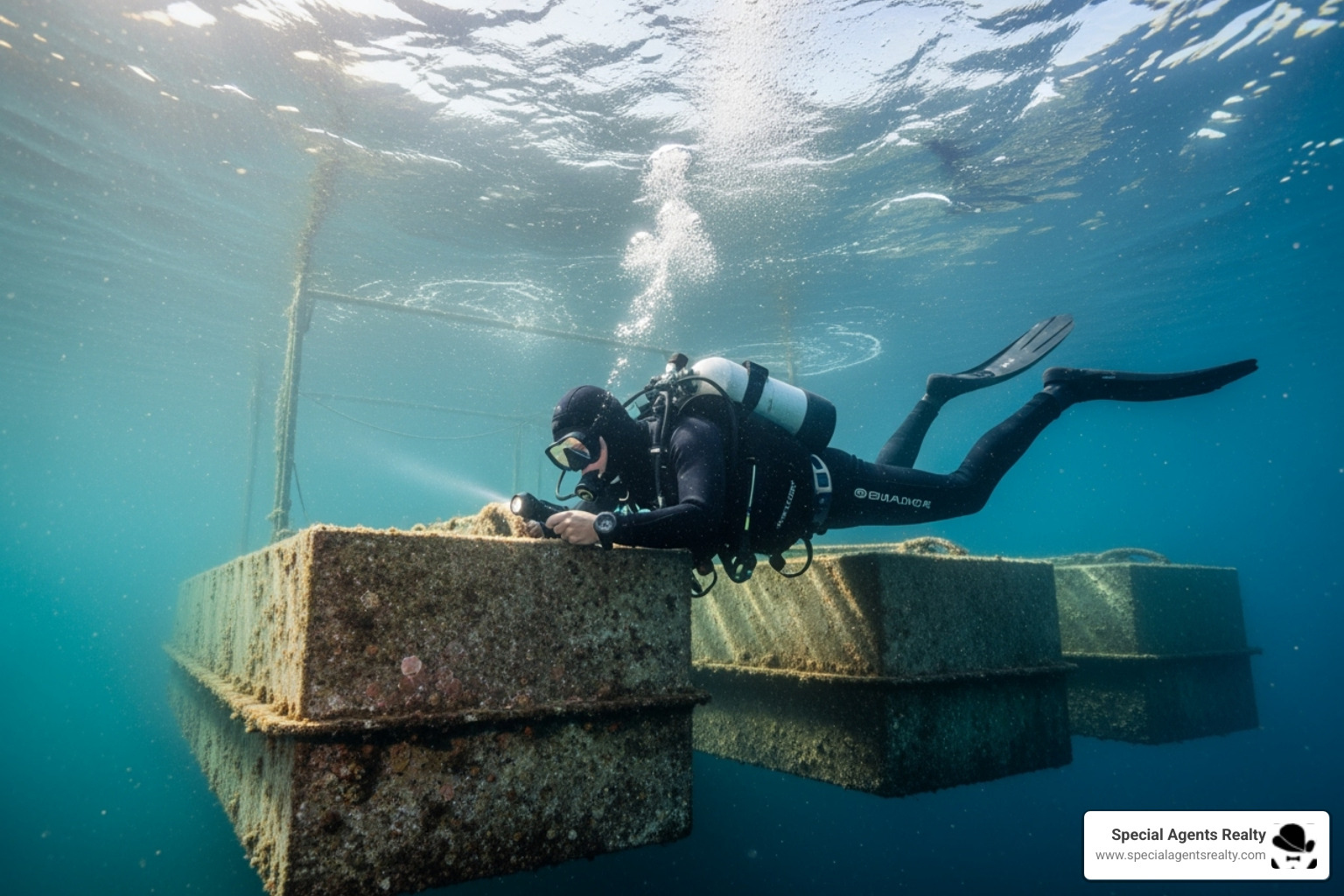
Managing Utilities on the Water
How you get power and water depends on whether you have a floating home or a houseboat (FOWR).
Floating homes are set up like a regular house. They connect directly to the electrical grid for full power and have direct sewer hookups, so waste management is identical to a land-based home. Water, internet, and cable are also hard-wired.
Houseboats operate differently. Because they are vessels, they typically have limited power (around 30 amps), requiring you to be mindful of simultaneous appliance use. For waste, houseboats use holding tanks that need regular pump-out services from companies like Pumpout Seattle. Graywater (from sinks and showers) has historically been a concern, but regulations are tightening to protect the lake's ecosystem.
Ongoing Maintenance Requirements
Your maintenance checklist will include a few unique items:
- Float or Hull Integrity: This is the most important task. Floating homes require dive inspections every few years to check the concrete float. Houseboats need to be towed to a shipyard for a drydock examination of the hull every three to six years.
- Siding and Roof Care: Constant exposure to moisture means regular cleaning, painting, and sealing are crucial to prevent wear and tear.
- Dock Maintenance: If you're part of a co-op, you'll contribute to the upkeep of shared decking, pilings, and utility connections.
- Weather Preparedness: Living on water means paying attention to storm warnings. Securing loose items and checking mooring lines becomes second nature, and dock communities often look out for each other.
Regulations and Environmental Considerations
Seattle's waterways are governed by a comprehensive framework overseen by the Department of Planning and Development (DPD) and the Shoreline Master Program (SMP). The SMP balances development with environmental protection, dictating the size, height, and location of floating structures.
Each property has a DPD plaque identifying it as a "floating home" or a "floating on-water residence (FOWR)," which determines the applicable rules. It's worth noting the DPD stopped verifying new houseboats after September 2021, so any current ones were grandfathered in. For houseboats, a liveaboard designation may be necessary for year-round residency.
Most importantly, living on the water means being a steward of the ecosystem. This involves using eco-friendly cleaning products, properly managing waste, and being mindful of what goes into the lake. Many communities have their own guidelines to protect water quality, and residents take pride in keeping their environment pristine.
The Seattle Floating Lifestyle: History, Community, and Unique Perks
Living on the water in Seattle is about joining a tradition that stretches back over a century. The floating home community has a history and a way of life that creates a unique, magical experience for its residents.
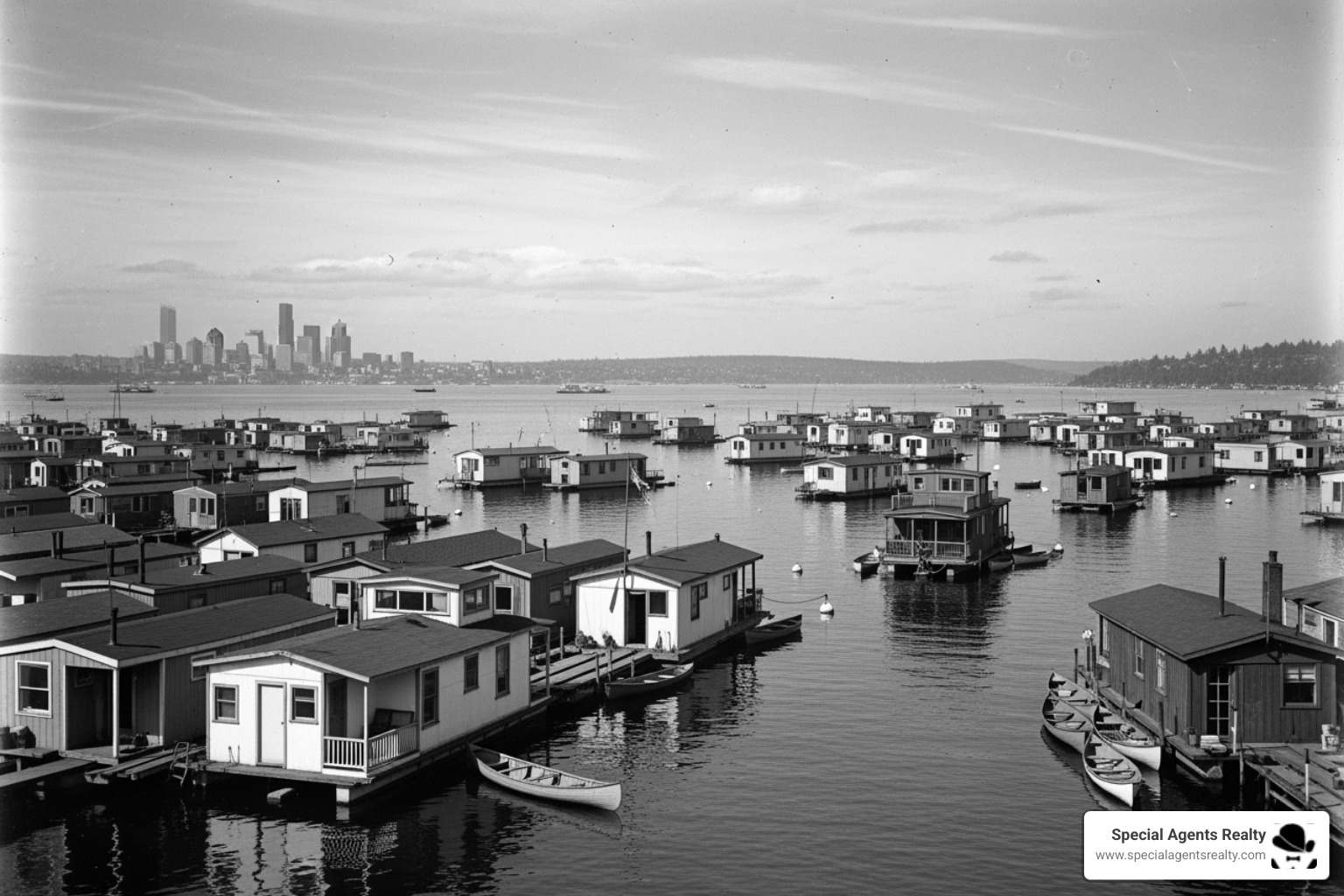
A Rich History on the Water
Seattle's floating homes began in the early 1900s as affordable housing for laborers. The community's geography shifted dramatically in 1938 when the city required houseboats on Lake Washington to connect to sewer lines. Unable to afford the cost, many owners towed their homes to Lake Union, which is why most floating home communities are found there today, even when people search for Lake Washington houseboats.
An icon of this era is the Wagner Houseboat. Built in 1912, it's one of Seattle's oldest floating homes and holds landmark status. Originally on Lake Washington, it made the historic journey to Lake Union in 1938. It later became the birthplace of The Center for Wooden Boats, founded by residents Dick and Colleen Wagner, who were passionate about preserving maritime history. You can learn more about its journey in The story of the Wagner Houseboat.
Benefits and Drawbacks of Floating Home Life
Life on the water is a trade-off. It's not for everyone, but for the right person, the benefits are unparalleled.
The Upsides:
- Instant Water Access: Step out your door to kayak or paddleboard.
- Stunning Views: Enjoy panoramic vistas of the city and water that change daily.
- Tight-Knit Community: Experience a rare neighborliness with dock potlucks and shared events.
- Unique Experience: The gentle rocking and connection to nature are things you can't replicate on land.
The Downsides:
- Limited Privacy: You live in close quarters with your neighbors.
- Space Constraints: Storage is often at a premium, especially in smaller houseboats.
- Maintenance Demands: You can't put off specialized tasks like dive inspections or hull work.
- Weather and Motion: You'll need to be prepared for storms, and while most adapt, the motion can be unsettling for some.
The Unique Lifestyle of Lake Washington Houseboats
What makes the floating home lifestyle so special is the accumulation of small, perfect moments. It's starting your day with a quiet kayak trip, watching seaplanes take off from Lake Union, and waving to neighbors on the dock. It's the impromptu gatherings, festive holiday boat parades, and front-row seats to Fourth of July fireworks over the water.
This lifestyle encourages you to slow down and connect with your surroundings and your neighbors. You become attuned to the weather and the rhythms of the water. It's a unique blend of urban vibrancy and natural tranquility that you simply can't find anywhere else. For those drawn to it, life on the water becomes more than just a place to live—it becomes part of who they are.
Frequently Asked Questions about Seattle Houseboat Living
Here are straightforward answers to the most common questions we hear from people curious about life on the water.
Can you live on a houseboat year-round in Seattle?
Absolutely. Both floating homes and properly designated houseboats (FOWRs) are built for year-round living. They are full-time residences with proper insulation, heating, and weatherproofing to handle Seattle's climate. Floating homes have direct utility hookups, while liveaboard-designated houseboats are similarly equipped for all seasons.
Are floating homes a good investment?
They can be an excellent investment, but they occupy a niche market. The key factor driving value is scarcity; with only about 500 floating homes and strict regulations preventing new ones, demand consistently outpaces supply. This has historically led to strong value appreciation, as reflected in the premium median list price of $738,000.
However, the market is smaller and more specialized than traditional real estate. You'll also have ongoing costs like dive inspections and HOA/moorage fees to factor into your investment calculations. For those who love the lifestyle, the investment potential is a solid bonus.
How difficult is it to get a mortgage for a floating home?
It's more challenging than a conventional mortgage but is entirely achievable with the right guidance. Expect a larger down payment requirement (typically 20-30%) and the need to work with specialized lenders like Sound Community Bank or Banner Bank, who understand this unique property type.
Getting pre-approved is crucial. In a market with limited inventory, having your financing ready shows sellers you are a serious, qualified buyer. Working with a real estate agent who has relationships with these lenders can make the process much smoother.
Conclusion
The dream of Lake Washington houseboats captures the imagination, evoking images of a life lived in harmony with the water, straight out of Sleepless in Seattle. As this guide has shown, the reality is both more complex and more rewarding than the dream alone.
Living on the water means embracing a unique lifestyle. You'll enjoy unparalleled views and a tight-knit community, but you'll also need to steer specialized financing, unique maintenance tasks, and specific regulations. These aren't obstacles but part of a package that offers an extraordinary experience—a constant connection to nature blended with urban vibrancy.
This lifestyle isn't for everyone, but for those drawn to it, there's nothing else like it. The key to making this dream a reality is having the right guidance. The specialized nature of floating properties means you need an expert who knows this unique world.
At Special Agents Realty, we've made it our mission to understand every detail of Seattle's floating home market. We know the communities, the regulations, and the lenders who can make your financing happen. We're here to help you take the next step, whether you're just exploring the possibility or ready to start your search.
.avif)

